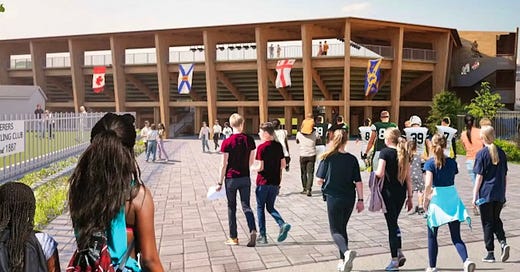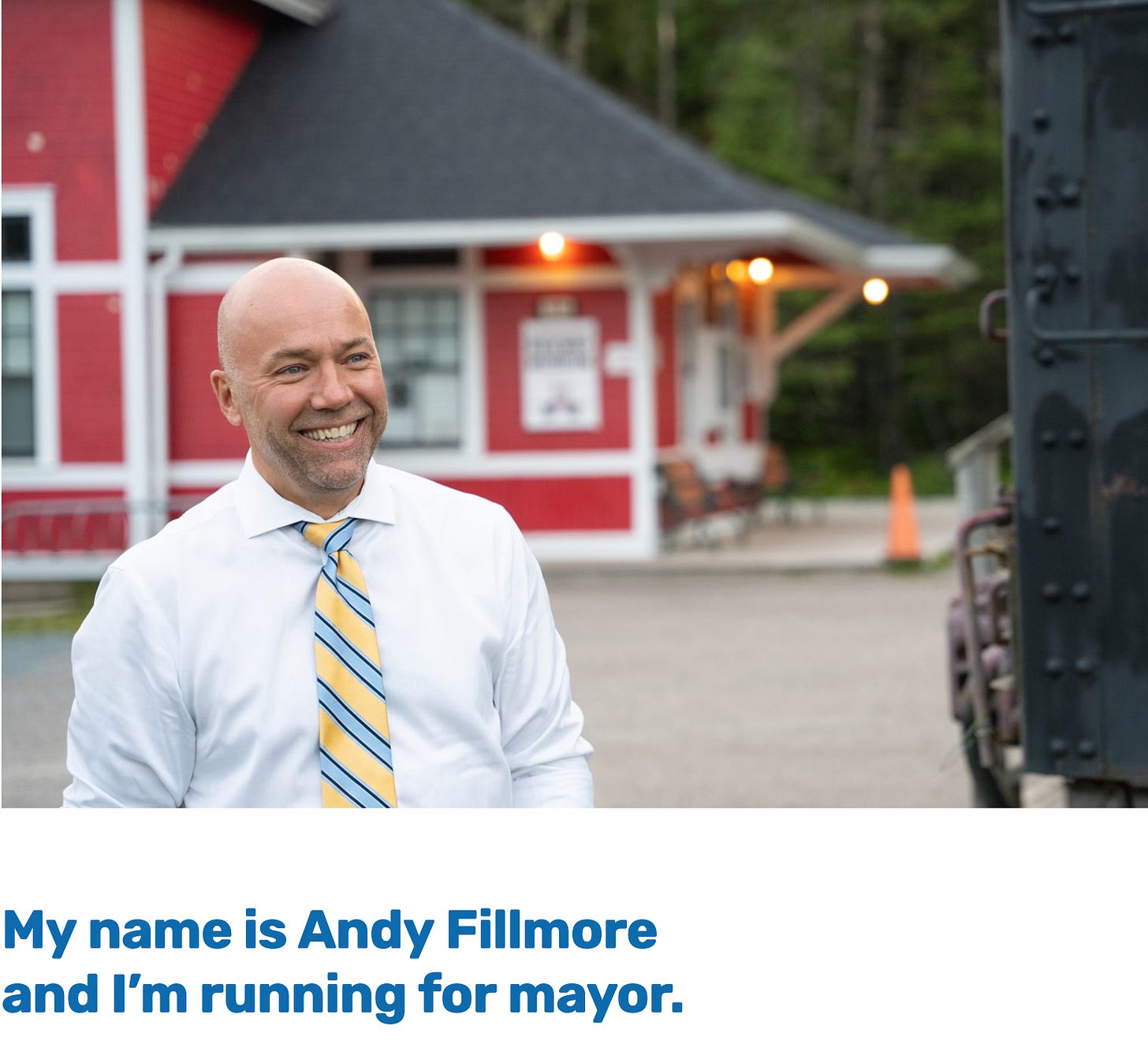The latest polls are in. They’re disheartening.
Nearly Half of Voters Unable to Name Any Mayoral Candidate as Halifax Election Nears
Those with a preferred choice are overwhelmingly leaning Fillmore based on name recognition.
Nine years of littering our doorsteps and mailboxes with federal Trudeau Liberal propaganda are finally paying off.
The polls…
Here’s Mr. Fillmore’s “For Mayor” page. The most interesting thing to note is that there is no policy page, no vision page, no nothing. His slogan is “I’m Andy Fillmore and I’m running for mayor.” Or maybe it’s “Meet the Moment”. It’s hard to say… and harder to say what that means. This is not good. He does state his purpose though… “to take charge of our future.” Ummm…
I’m going to share one of my concerns… Stadiums.
By my accounting, it’s been about 9 months since the last “Halifax NEEDS a Stadium” media blast from the Develop Nova Scotia and various crowds…
I am concerned this issue will move to the top of the pile as Mayor Fillmore is wined and dined by the Halifax City elites.
The Stadium Question
Do you think the idea of a stadium is awesome or actually the best thing ever?
How big should the stadium be, 20k, 50k, 100k, bigger?
What are some of the most awesome things that we could dream of doing in a stadium?
If the stadium is totally awesome, what would be the fastest and easiest way of getting there?
Finally, how great would it be for you to have your own stadium where you and all your friends could go to rock out?
As you may guess, I’ve been to Halifax stadium “consultations and open houses” before. One thing I can report is that they are NOT public meetings or discussions about the merits of investing in a stadium over other possible investment choices or important priorities for the community.
Nope, they are full-on cheerleading sessions and a citizen would have to have a heck of a lot of nerve at such an event to say anything except “Go Team”. Luckily, or unluckily for me I suppose, I have that nerve.
The politicians are never able to articulate any realistic circumstances where they and the “public consultation team” would actually not recommend going forward with the stadium building process. The bureaucrats love this of course - the slow walk: plodding forward, excited to be building something, coaxing and cajoling one tiny little push at a time, never upsetting anyone, never really admitting the agenda. It is the ever-expanding universe of government bureaucracy incarnate if obfuscated. And then boom… one day the line of talk changes to “it’s been decided”. A faith acompli. Nothing can be done now. Though no one is responsible and no names are attached. The decision has irrevocably been made… somehow.
Stadiums are Bad Business, and even Worse Infrastructure
There are even more than a few books written about the bad-horrible-bad economics of stadiums.
Halifax is at a crossroads, and the choice of leadership in the coming election could steer the city down starkly different paths. One candidate that has stirred conversation is Andy Fillmore, whose previous tenure as head of planning in Halifax left a controversial legacy. A Fillmore win might seem like a nod to progress, but there are whispers—and shouts—that it could mean a return to the old dream of building a sports stadium. In a city grappling with a housing crisis and homelessness, the prospect of shifting focus back to such grand projects raises significant concerns.
The Sports Stadium Mirage
Sports stadiums have a history of being sold to cities as economic catalysts, but the reality often falls short. The idea of a stadium in Halifax is a mirage that has come and gone, with advocates promising jobs, tourism, and a boost to local businesses. The books Public Dollars, Private Stadiums by Kevin J. Delaney and Rick Eckstein, and Field of Schemes by Neil deMause make it clear: these projects rarely deliver on their lofty promises. Instead, they become public money pits that siphon funds away from other crucial priorities like housing and social services.
In Public Dollars, Private Stadiums, the authors analyze case after case of stadiums that failed to generate the promised economic growth. Cities end up shouldering the debt, while developers and team owners reap the benefits. The story is no different in Field of Schemes, which details how cities become enamored with the idea of a "world-class" sports venue, only to find themselves trapped in a cycle of escalating costs and underwhelming returns. Halifax can't afford to fall into this trap, especially not now. Well, the truth is it can afford it… but at the expense of other more important things.
Fillmore’s Track Record
Andy Fillmore's history in Halifax planning is mixed. As an urban planner, he has shown vision and an understanding of the importance of density and development. But it's also true that his time in planning was marked by a certain penchant for grand visions. And the time for stuffing more big box high-density “solutions” onto a painfully under-infrastructured peninsula is over. His previous support for projects like the Convention Centre reflected a belief in any big, transformative projects—given the right pressure from developers and business interests. The work-a-day problems of the city probably would not exist today if not for the ‘transformative world-class work’ of the past Fillmore era.
Fillmore’s vision leans more toward flashy, skyline-changing projects than the gritty, hands-on work of creating affordable housing and livable neighborhoods. The Zoning and Urban and Up ideology of his old professors have been proven failures from a human perspective. It’s going to take a generation to undo the mess. And this is the problem: with a mayor pitching for stadium (developer) dreams, will Halifax’s current affordable housing crisis continue to be treated like an inconvenience underfoot?
The Real Need: Homes, Not Stadiums
Halifax's population is growing, with many drawn to the city for its quality of life and coastal charm. But this growth has come at a price: skyrocketing rents, scarce housing supply, and a rising homeless population. Addressing these issues requires relentless focus and a willingness to tackle the less glamorous challenges of zoning reform, social housing, and incentives for affordable developments. This is not the kind of work that gets a politician’s name on a commemorative plaque—but it is what Halifax needs.
A sports stadium may make for great photo ops and ribbon-cuttings, but it doesn’t address the fundamental issue that Halifax faces: the need for affordable homes. As detailed in Field of Schemes, the opportunity cost of investing in a stadium is staggering. Every dollar spent on a stadium is a dollar that could have gone toward building homes, shelters, or community spaces that directly address the needs of the city’s most vulnerable.
Halifax at a Crossroads
A Fillmore term as head-gremlin-in-the-works could bring with it a focus on grand urban visions, but at what cost? The allure of a stadium might appeal to those looking to put Halifax on the map, but it would likely come at the expense of a more grounded, pragmatic approach to city governance—one that prioritizes the immediate and pressing needs of residents over the allure of a grand civic landmark.
As Halifax heads into this election, voters must ask themselves: Do they want a leader who might be tempted by the dream of a stadium, or one who is ready to roll up their sleeves and tackle the hard, unglamorous work of making housing affordable and accessible? If the answer is the latter, then the choice seems clear. Not Fillmore. The city can't afford to chase another mirage while real problems continue to fester.
When the Symbol is Mistaken for the thing Symbolized
It’s an all too human failing. The symbols of economic prosperity have been swapped for actual economic prosperity. For the bureaucrat, the consultant, and the politician it is an absolutely no lose game. They are going to get more money, more business, power, and more votes no matter how misguided their low populist scheme is.
Many people, weary of having less, believing they deserve some of that green grass, are like a Pacific Island Cargo Cult easily convinced that the symbol will bring back the thing it is intended to symbolize. Clearly, this is exactly backwards but the dissipated siren call is luscious.
More problematic still, public investment in mega-projects, concerts, games, stadiums, parties, and the like requires a complete redefinition of Infrastructure.
What is Infrastructure?
Infrastructure used to mean the technical structures that support a society, such as roads, water supply, sewers, electrical grids, telecommunications, and so forth. In the early days, it simply meant wharves and roads to wharves. In some rural places, we still say government wharf or government road. Viewed functionally, infrastructure facilitates the production of goods and services, and also the distribution of finished products to markets, stretched to the limit it includes basic social services such as schools and hospitals; for example, roads enable the transport of raw materials to a factory.
When the definition of infrastructure is expanded to include stadiums, leisure facilities, convention centres, and the booster groups required to make these things happen, the plot is lost entirely and the government is ‘investing’ in projects that should be the outcome of economic growth, not the drivers.
Then we are all left scratching our heads wondering why there is not enough money to even pay staff and keep the roads and sidewalks in good repair.
The community is faced with a problem - a lack of economic activity relative to the population. When told that convention centres, stadiums, games, and concerts are good things most agree that they want good things, who wouldn’t, so yes - build a stadium. But this kind of politics is manipulative and low populist, frankly, a game growing pretty old in Nova Scotia.
We are confusing “nice to have” with “need to have”. We’re not investing in the traditional sense. We are not doing what any individual person would do. A person would count up how much money they have, and how much they could take the risk to borrow, set a budget, and then choose between all known possible alternatives to maximize their long-term wealth. What are we doing? We’re just plain old spending on candy because we want it.
The question remains unasked - is a stadium, like the convention centre before it, the very best investment choice we can make with our limited resources of capital, debt, time, government, and attention, to improve the prospects for Nova Scotia sustainably into the future?
Many like myself are looking to our government to have the resolve and the vision to actually use the power of investment to help us find a new way forward to build balance, and strengthen our economy, our society, and our environment in Nova Scotia.








